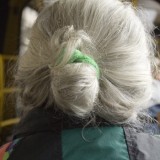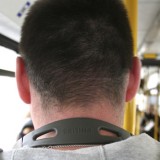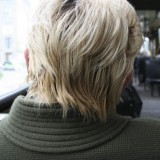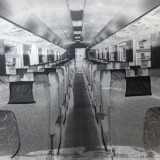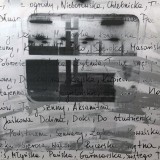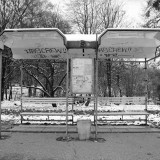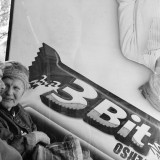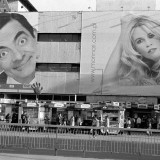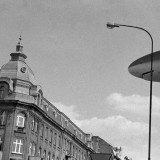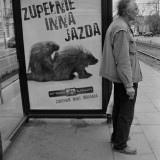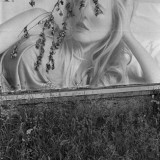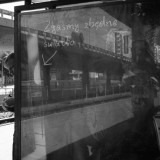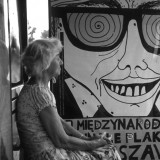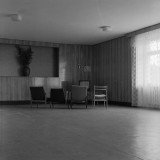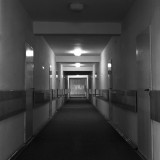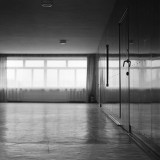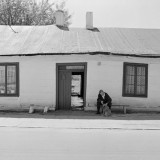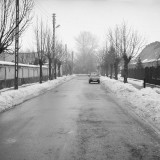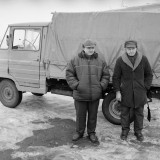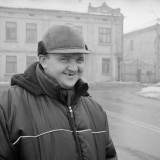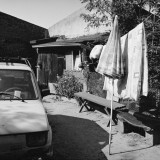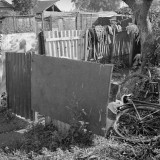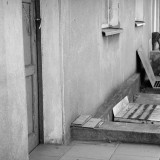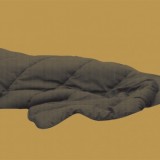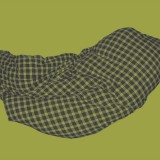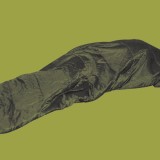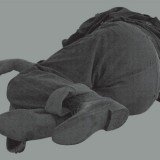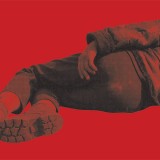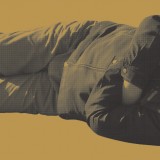Katarzyna Łukasik
Katarzyna Łukasik works in the media of photography, graphics and set design. She graduated from the Department of Graphics and Painting of the Academy of Fine Arts in Łódź in 1998. In 2010 she received a Ph.D. in Fine Arts. She lives in Łódź and since 2012 she has worked in the Academy of Fine Arts in Gdańsk. She received many awards and distinctions, such as an award from the Visual Artists’ Union in Warsaw during the 7th Triennial of Polish Graphics in Katowice in 2009. She has exhibited in Poland, France and Germany.
Katarzyna Łukasik’s graphics are based on photography and they are composed using a silk-screen printing technique. In her graphics she usually reduces the elements of reality and in her photographs she carefully observes reality and shows situations, events and people from a surprising perspective.
The series of graphics entitled Absent shows homeless people. Usually they are transparent to us in the context of the town, unless a smell betrays the fact that they are around or they ask for 50 pence. But at the same time seeing the homeless is so common that it doesn’t provoke any emotions. The artist photographs the homeless sleeping on benches, at bus stops or simply on the ground and takes their silhouettes out of the context and deprives the image of colour. Then she places the figures which are “separated” like that on a flat background – red, green or brown and gold. This way the sleeping people are somehow “distilled” from the real world and obtain a certain poetics and timelessness. They are often huddled up, we don’t see their faces. The strongest and most radical works from the series are two graphics on which one can see only a sleeping bag and a blanket under which we see only the contour of a human silhouette. We ask ourselves, is there a person there and is he/she alive? The covering of the body and face we associate with death. The topic of sleeping brings to mind the topic of dreams, often prominent through art history. Do people from Kasia Łukasik’s graphics dream about anything? Has anybody ever wondered what the homeless dream about?
An interesting development within the presentation of the work was relocating the graphics from the series Absent from a gallery space back to the shabby tunnel at the former railway station Łódź Fabryczna, which happened during the Fluo-Session Festival. A few paintings were put on the ground or hung on the walls. The silhouettes were emanating with internal light, bringing to mind associations with life, the warmth of people’s bodies huddled up in the recesses of the cold, concrete structures.
A dreamlike world appears within Katarzyna Łukasik’s photographs. The series entitled Uknown City, Sceaux, My City and Piątek are photographs of the cities or towns – real places, which in her photos look unreal. This is caused by the fact that the photographs are black and white, making the relations between shapes are more clear and the visual qualities of items are highlighted.
Sometimes the artist photographs a similar motif and contrasts the results. She uses a conceptual art measure, but she uses it to build atmosphere, as with the series of photographs, which she showed during the exhibition in a former prison in Łęczyca. On a few dozen photos of the size of a business card, there are gates, often very elegant, equipped with an intercom and a camera. They hide what’s going on behind them and become a border between two worlds. Through the repetition of the motif in a number of variations the artist strengthened the message.
In the series Stops the artist also focused on photographing a series of similar objects. However she was more interested in what was going on at the stop, in the context created when photographing a certain unique situation, combining people who will never sit down in the same configuration ever again. Only now two ads accidentally hung next to each other all of a sudden start to make a dialogue with each other. A surprising composition of people and objects revealed just for one occasion must be preserved.
On photographs from the town named Piątek, the artist plays with photography as a way of documenting time. The photos could be shown as a registration of the life and surroundings of the inhabitants of Piątek 40 years ago. Only the artist’s age and maybe some small details show that something is wrong here.
In the series entitled Polańczyk she photographed interiors of a communist resort house. It’s a phantom hotel – there are no people there, long hallways belch coldness and emptiness. This is our first impression, but when we look at the details we may be touched by the common room with a TV, wood panelling on a wall, or linoleum on the floor.
The photographic series of Kasia Łukasik are the registrations of various places and towns, as if the artist tried to describe her surroundings through photography wherever she is in order to build her own system of signs – identifications of the place.
The artist also registers time and space “between” when she moves from one town to another. In Moving studio she photographed people, who were sitting in front of her on a tram, train, or at the airport. These are specific busts, because instead of a face we see in a cramped frame, the back of a head, accidental and anonymous companions of Kasia’s trips.
In the end it’s worth coming back to graphics – the latest diptych of serigraphs Between – Postcard from the trip 01 and Postcard from the trip 02. Both black-and-white, just like photographs, but in a much larger format than a postcard – 100x70 cm. Lately Kasia spends a lot of time travelling between Łódź and Gdańsk. On the first graphics we see a slightly blurred train window and handwritten names of Gdańsk streets. On the other – an empty train car – an image presented as a negative.
The art of Kasia Łukasik is an expression of what she sees and meets in the closest vicinity and she notices a lot, as within the banality of things she can spot their originality.
Anka Leśniak
more at the artist's web site



